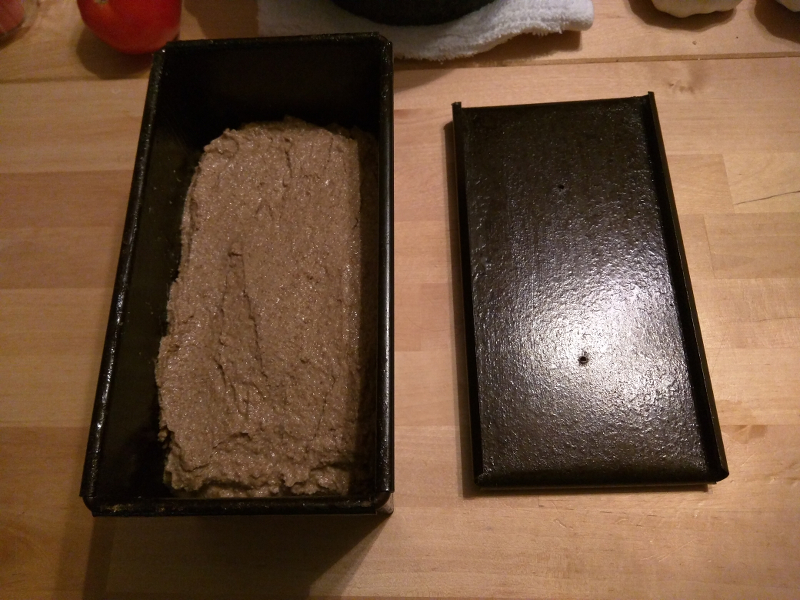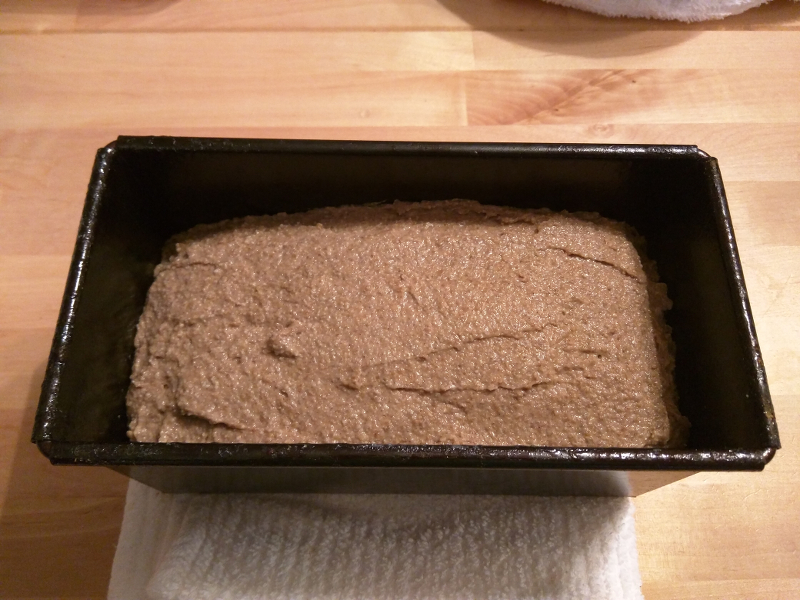Making my first loaf of bread. I could use some feedback on the proofing bit, which is happening now.
It's been three hours between these photos, and my paste hasn't risen like I hoped.
Before:

Half an hour ago:

It is rising though!
Sorry if this has been covered. I tried to search, but most of the proofing advice didn't seem applicable to 100% rye, 100% hydration dough. Kind of a niche I guess. Juergen's post here has good photos of a similar dough proofing. I'm jealous.
How should I proceed? Juergen suggests waiting until bubbles appear in the surface. How long is too long? And does it need to be covered with more than just the pullman lid so it doesn't dry out during this extended proof?
Thanks for looking!
it cracks it is ready for the oven. I usually fill the tins 3/4th full since rye doesn't rise much and when it gets to the rim level in the middle of the dough it is thoroughly cracked. Yours looks to be half filled. it probably won't get there and if it does it will be over proofed and likely fall in the middle when baked. Good luck!
I see Juergen filled his tins half full too but thought they were a bit over proofed when they got to the rim in the middle. His turned out well though.
Thanks for the reply! I've seen that tip mentioned, but I didn't know if that would change the taste. Seems like a good idea though, especially for someone trying an unfamiliar amount of dough, unsure where it should end up. Should've done that!
Welp, for better or worse it's in the oven now. This was taken shortly before it went in.
Didn't follow any real indicator that it was ready. I looked at the paste really close and saw some tiny holes that might've been formed by bubbles, but they looked nothing like Juergen's picture. Mostly I just didn't want to overproof.
Even if it's a failure, a lot of things have gone alright. Hoping it doesn't stick!
too and that would mean to get it baked asap.
i see from the time, I,m too late for immediate help. My connection is not the best but the paste looks pretty good from here. How did it bake out? Or is it still in the oven? If not yet baked, dock the surface.
Don't cut until tomorrow. :).
I'll take your posts when I can get them. Sorry to say that it went in undocked.
Welp, the loaf is overcooked.
The target internal temp was 205. Cooked it for 10 minutes at 500. Then I set the oven to 350 for 2 hours. Next time I'll probably try a lower second temperature - like 325 for 2 hours.
So proud.
And... it's stuck.
Had to run a paring knife around the edges and use a lot of inertia, but I got it out intact. The pan wasn't too hard to clean, so it could've been worse. Not sure if there's a lesson about greasing here, since I did overcook it and that tends to make things stick more than they otherwise would.
The plan is to wait until Monday morning before cutting, through sheer tyranny of will. Right now it's 2:53 a.m. on Sunday and I'm letting it cool on the rack. The unexpectedly long proof made this experiment run late. Hopefully my starter grows more potent through repeated use and shortens the proof in future attempts. It was over 6 hours this time. I'm sleepy, but satisfied.
As you can see from the shot above, the top of my loaf is sunken in. So I definitely overproofed it, right?
Starting at 3 hours into the final proof, I took a shot every hour.
3 hours:
4 hours:
5 hours:
6 hours (less than half an hour before baking - had to reheat the oven):
I really don't know when the right time to start cooking was. I should probably try sprinkling my next loaf with flour, as dabrownman suggested. I'm assuming my starter was a bit sluggish, but does that lower the ceiling of my rise or just slow things down?
Juergen's photos show his dough rising a lot more than mine. The biggest difference between the basic composition of my dough and Juergen's, aside from the starter, is that I scalded 20% of my flour. Does that limit the height of my loaf?
For my next attempt, would you recommend that I increase the amount of dough in this pan?
I used 600 grams of flour and 600 grams of water. The sum of my recipe was 1240 grams.
That's all the questions I can think of, but any observations or advice would be much appreciated!
and see how that goes to filling the pan tp the top. Donlt forget to grease the pan well so it doesn't stick. Bake at 350 for 1 hour then turn down to 300 until it is reads 205 F on the inside - maybe an hour more. The sunken roof means it was a bit over proofed.
Not bad for a first shot, It will taste fine bt let it redistribute the moisture inside before slicing - at least 2 hours. Mini is the 'Rye Queen' and a benevolent one I might add.
I make these 2-3 times a week but I'm somewhat surprised at your cooking times though... Usually I put them into the oven at 250°C (480F) for 12 minutes then down to 200°C (390F) for the remainder - but that's only 25-30 minutes before it hits the 97°C I'm looking for. I always tell my customers to wait until tomorrow, but most never do...
My mix is about 95% hydration though, so a shade less than yours. It also has (depending on the bread) some malt extract and molasses in it too.
I start middle of the afternoon and make the "production" sourdough starter from my starter that lives in the fridge - this is at 150% hydration, then in the evening I make up the dough - really nothing more than stir all the ingredients together then slop into tins, or onto the bench to roll some figs into it and plop into a very well rye floured banneton, then I put them in bags and let them rise in the fridge overnight (At the top of the fridge, so not that cold, relatively speaking, although the fridge does have a fan!) then let them come up to room temperature in the morning while the ovens are heating up, then bake.
Some photos I took a while back - these are small loaves - about 540g of dough in the tins, a little more in the banneton.
So the night before:
In the morning: (dusted the tins with rye flour before scoring)
and baked:
The overnight rise isn't spectacular - hard to see from those photos, but the tins are filled to about 2/3 capacity and it usually rises to the top overnight. The banneton is usually filled out too.
My base recipe for 2 small loaves or one large one is 400g starter (at 150% hydration), 400g flour, 260g water, 8g salt, then some extras - like 20g malt extract, 20g molasses and 6g caraway seeds... I use mostly light rye flour.
-Gordon
is pretty tricky. ...but look at the finished baked "stuck" loaf and compare to the hourly rise photos. Obviously it didn't rise much in the oven so you will need to back up a bit and get it in earlier so the steam can do some of the work. Not bad, not bad at all. Can't wait to see the crumb. (Let's expect the worst and then be pleasantly surprised.) :)
When I have so many hours to wait, I tend to reshape about one third (or a little bit more) into the total rise time after mixing up the dough. So that would be at about the two hour mark. Let the dough continue to rise in the bowl after mixing and then give it a few folds in the air with wet hands or most likely just get a big wet spoon and spoon it into the buttered and floured (or seeded) pan.
:)
Here is the crumb.
Y'know, for a minute there I was kinda worried, but I guess I'm a natural at this. Can't improve on perfection!
Dabrownman, I'll try 700 grams next time. I considered 800, and I doubt it would overload the pan, but I'd rather go up incrementally to be safe. One less thing to worry about. I thought I greased the pan well enough, but I'll be extra careful next time. And I'll try not to overcook this one! Guess I was pretty far off.
Drogon, my cooking times and temps were complete guesswork. Andy starts his Borodinsky hot and then does a long bake - even longer than the one I tried. I was aping much of his process and formula, but I have no idea what I'm doing. Your loaves look lovely. Thanks for the inspiration. I read up on retarding the ferment overnight after reading your post, and the scheduling benefits of that convinced me to try it for my second attempt. This will be an entirely different process.
Mini, it's probably worse than you suspected. Fortunately, I've found that I like the flavor of rye bread well enough to pursue this. That's a very happy discovery for me, since I bought my rye berries and molasses in bulk. I'd only eaten 'rye' bread sandwiches at low-end restaurants before this experiment, so I wasn't sure what to expect. I do see how little oven spring there was between those photos you mentioned. Duly noted.
I assume that the gumminess in the center has more to do with over-proofing and the resulting cave-in than the hydration. I certainly waited long enough to cut into it. Under that assumption, I'll be trying 100% again. The loaf is very moist and pleasantly sour. The texture is pretty bad and the loaf is hard to cut, but I'm enjoying it well enough in small quantities with just butter. I also like the color, and I'm interested to see how much that changes when I cook it less.
Thanks again for the support everyone